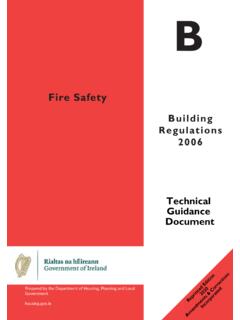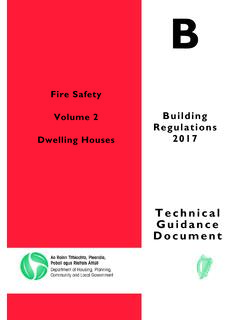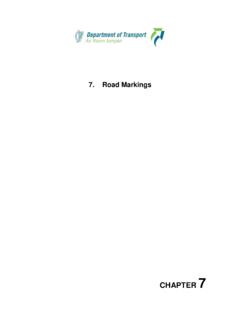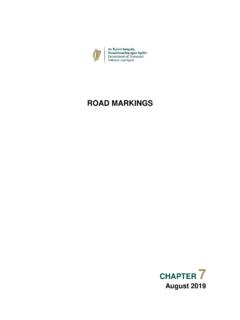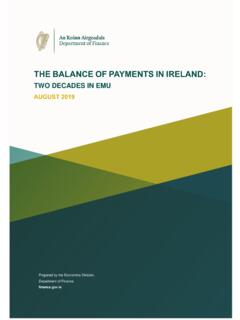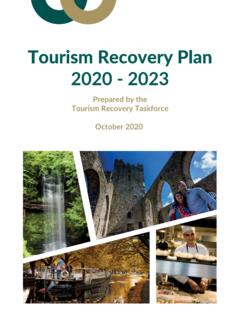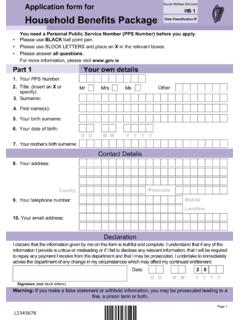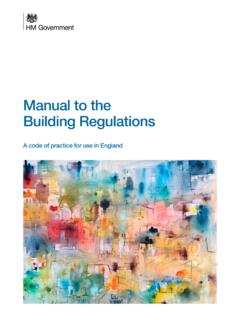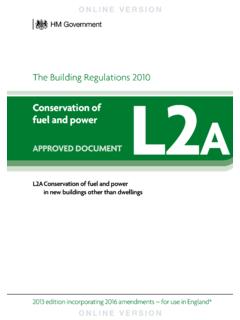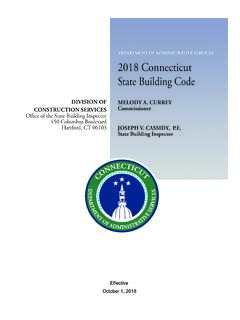Transcription of Building Regulations
1 Building Regulations Technical Guidance Document L 2021 Conservation of Fuel and Energy Buildings other than Dwellings Prepared by the Department of Housing, Local Government and Heritage Government of Ireland 2021 Contents Page Introduction 1 Transitional arrangements 2 The Guidance 2 Technical Specifications 2 Materials and Workmanship 3 Interpretation 3 Part L - The Requirement 4 Section 0: General Guidance 7 APPLICATION OF THE Regulations 7 General 7 New Buildings other than Dwellings 9 Existing Buildings other than Dwellings 11 TECHNICAL RISKS AND PRECAUTIONS 12 General 12 Fire safety 13 Ventilation 13 THERMAL CONDUCTIVITY AND THERMAL TRANSMITTANCE 13 DIMENSIONS 15 DEFINITIONS 15 APPLICATION TO BUILDINGS OF ARCHITECTURAL OR HISTORICAL INTEREST 17 Contents Cont d Section 1.
2 New Buildings other than Dwellings 19 LIMITATION OF PRIMARY ENERGY USE AND CO2 EMISSIONS 21 RENEWABLE ENERGY TECHNOLOGIES 23 Building FABRIC 25 General 25 Fabric Insulation 25 Thermal Bridging 28 Building Envelope Air Permeability 29 Limiting the Effects of Solar Gain in Summer 31 Limiting Overheating 32 Building SERVICES 32 Heat Generator Efficiency 32 Controls for Space Heating and Hot Water Supply Systems 33 Air Conditioning and Mechanical Ventilation (ACMV) 38 Air Conditioning and Mechanical Ventilation (ACMV) Controls 41 Insulation of Storage Vessels, Pipes and Ducts 44 Artificial Lighting 44 Electric Vehicle Recharging Infrastructure 47 CONSTRUCTION QUALITY AND COMMISSIONING OF SERVICES 49 General 49 Insulation Continuity and Air Permeability 49 Thermal Bridging 49 Air Permeability Pressure Tests 50 Commissioning Space and Water Heating Systems, Air-conditioning and Mechanical Ventilation Systems and Renewable Systems 51 USER INFORMATION 51 General 51 Contents Cont d Section 2.
3 Existing Buildings other than Dwellings 53 Building FABRIC 55 General 55 Fabric Insulation 55 Thermal Bridging 58 Air Permeability 61 Building SERVICES 62 General 62 Heating Generator Efficiency 63 Controls for Space Heating and Hot Water Supply Systems 63 Air Conditioning and Mechanical Ventilation (ACMV) 64 Air Conditioning and Mechanical Ventilation (ACMV) Controls 67 Insulation of Storage Vessels, Pipes and Ducts 68 Artificial Lighting 69 MAJOR RENOVATION 70 Electric Vehicle Recharging Infrastructure 71 CONSTRUCTION QUALITY AND COMMISSIONING OF SERVICES 72 General 72 Insulation Continuity and Air Permeability 72 Commissioning Space and Water Heating Systems 72 Air Leakage Testing of Ductwork 72 USER INFORMATION 73 General 73 Appendices 74 A Calculation of U-values 75 B Fabric Insulation.
4 Additional Guidance for Common Constructions 87 Contents Cont d C Reference Values for Calculation of MPEPC and MPCPC 103 D Thermal Bridging 106 E Specific Fan Power 108 F Lighting 110 G Pipework and Ductwork Insulation 114 Abbreviations 117 Standards and Publications 118 1 Introduction This document has been published by the Minister for Housing, Local Government and Heritage under Article 7 of the Building Regulations 1997. It provides guidance in relation to Part L of the Second Schedule to the Building Regulations as inserted by Building Regulations (Part L Amendment) Regulations ( No. 538 of 2017) and the European Union (Energy Performance of Buildings) Regulations 2021 ( No.)
5 393 of 2021). The guidance in this document applies to buildings other than dwellings. The Part L Regulations and the European Union (Energy Performance of Buildings) Regulations (and this document) partly transpose the EU Energy Performance of Buildings Directive Recast (EPBD Recast) 2010/31/EU of 19 May 2010 and amending Directive 2018/844 of 30 May 2018, Articles 2, 3, 4, 6 (part of), 7, 8 (part of) and 9(3(b)). These requirements include: application of a methodology for the calculation of the energy performance of buildings on the basis of a general framework set out in Annex I to the EPBD (recast); setting of minimum energy performance requirements for buildings and the application of these requirements to new buildings to achieve Nearly Zero Energy Buildings; ensuring where buildings undergo major renovation that the renovated systems and components meet minimum thermal performance requirements in so far as this is technically, functionally and economically feasible.
6 Ensuring that when a Building element that forms part of the Building envelope and has a significant impact on the energy performance of the Building envelope, is retrofitted or replaced, the energy performance of the Building element meets minimum energy performance requirements in so far as this is technically, functionally and economically feasible; setting minimum electric vehicle recharging infrastructure provisions for new buildings and for buildings undergoing major renovation where there are more than 10 car parking spaces; ensuring, where technically and economically feasible, that new buildings are equipped with self-regulating devices for the separate regulation of the temperature in each room or, where justified, in a designated heated zone of the Building unit in accordance with the controls requirements outlined in Sub-sections and ; and in existing buildings the installation of such self-regulating devices shall be required when heat generators are replaced.
7 The guidance in this document also gives due regard to the cost-optimal levels of minimum energy performance requirements submitted in Ireland s report to the Commission under Article 5 of the EPBD Recast Directive 2010/31/EU of 19 May 2010. The Part L Regulations (and this document) set energy performance requirements to achieve Nearly Zero Energy Buildings performance as required by Article 4(1) of the Directive for new buildings. This document should be read in conjunction with the Building Regulations 1997-2021 and other documents published under these Regulations . 2 In general, Building Regulations apply to the construction of new buildings and to extensions and material alterations to existing buildings.
8 In addition, certain parts of the Regulations apply to existing buildings where a material change of use or a major renovation takes place. Otherwise, Building Regulations do not apply to buildings constructed prior to 1 June 1992. Transitional Arrangements In general, this document applies to works, or buildings in which a material alteration or change of use or major renovation takes place, where the work, material alteration or the change of use commences or takes place, as the case may be, on or after 27 July 2021. Technical Guidance Document L - Conservation of Fuel and Energy (2017 edition) ceases to have effect from 26 July 2021.
9 However, the requirement set out in Regulation 5(e) shall not apply to a Building : where the submission of a notice has been made in respect of the Building work concerned on or before 10 March 2021, or that is owned and occupied by, as the case may be, a small or medium-sized enterprise. Where the submission of a notice has been made on or after 11 March 2021 then the requirements of Regulation 5(e) apply. The guidance for Regulation 5(e) is contained in Paragraphs and The Guidance The materials, methods of construction, standards and other specifications (including technical specifications) which are referred to in this document are those which are likely to be suitable for the purposes of the Building Regulations (as amended).
10 Where works are carried out in accordance with the guidance in this document, this will, prima facie, indicate compliance with Part L of the Second Schedule to the Building Regulations . However, the adoption of an approach other than that outlined in the guidance is not precluded provided that the relevant requirements of the Regulations are complied with. Those involved in the design and construction of a Building may be required by the relevant Building control authority to provide such evidence as is necessary to establish that the requirements of the Regulations are being complied with. Technical Specifications Building Regulations are made for specific purposes, to provide, in relation to buildings, for the health, safety and welfare of persons, access for people with disabilities and the conservation of fuel and energy.
